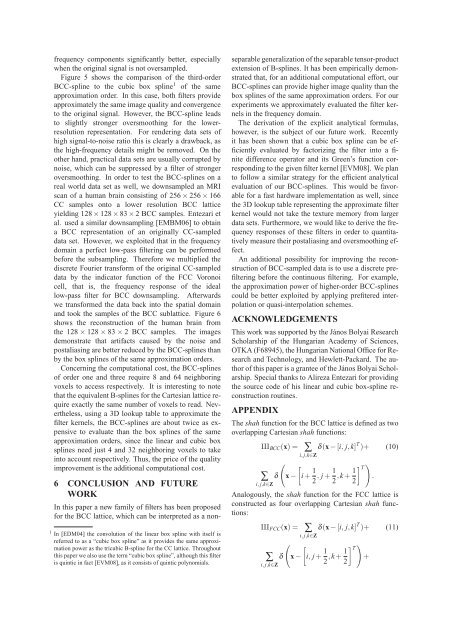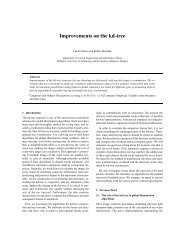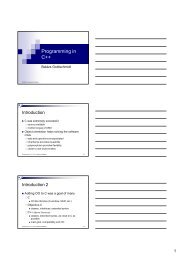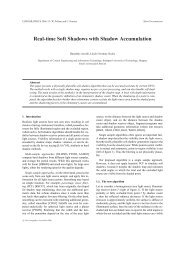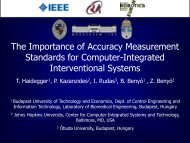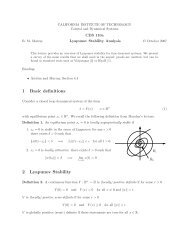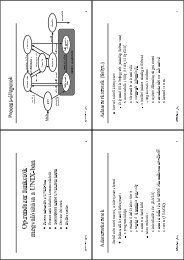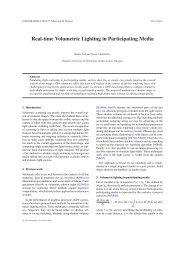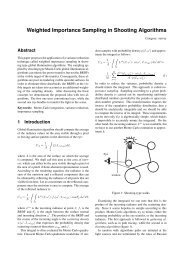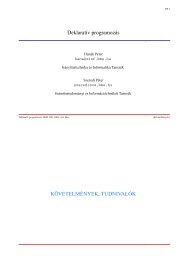BCC-Splines: Generalization of B-Splines for the Body-Centered ...
BCC-Splines: Generalization of B-Splines for the Body-Centered ...
BCC-Splines: Generalization of B-Splines for the Body-Centered ...
You also want an ePaper? Increase the reach of your titles
YUMPU automatically turns print PDFs into web optimized ePapers that Google loves.
frequency components significantly better, especially<br />
when <strong>the</strong> original signal is not oversampled.<br />
Figure 5 shows <strong>the</strong> comparison <strong>of</strong> <strong>the</strong> third-order<br />
<strong>BCC</strong>-spline to <strong>the</strong> cubic box spline 1 <strong>of</strong> <strong>the</strong> same<br />
approximation order. In this case, both filters provide<br />
approximately <strong>the</strong> same image quality and convergence<br />
to <strong>the</strong> original signal. However, <strong>the</strong> <strong>BCC</strong>-spline leads<br />
to slightly stronger oversmoothing <strong>for</strong> <strong>the</strong> lowerresolution<br />
representation. For rendering data sets <strong>of</strong><br />
high signal-to-noise ratio this is clearly a drawback, as<br />
<strong>the</strong> high-frequency details might be removed. On <strong>the</strong><br />
o<strong>the</strong>r hand, practical data sets are usually corrupted by<br />
noise, which can be suppressed by a filter <strong>of</strong> stronger<br />
oversmoothing. In order to test <strong>the</strong> <strong>BCC</strong>-splines on a<br />
real world data set as well, we downsampled an MRI<br />
scan <strong>of</strong> a human brain consisting <strong>of</strong> 256 × 256 × 166<br />
CC samples onto a lower resolution <strong>BCC</strong> lattice<br />
yielding 128 × 128 × 83 × 2 <strong>BCC</strong> samples. Entezari et<br />
al. used a similar downsampling [EMBM06] to obtain<br />
a <strong>BCC</strong> representation <strong>of</strong> an originally CC-sampled<br />
data set. However, we exploited that in <strong>the</strong> frequency<br />
domain a perfect low-pass filtering can be per<strong>for</strong>med<br />
be<strong>for</strong>e <strong>the</strong> subsampling. There<strong>for</strong>e we multiplied <strong>the</strong><br />
discrete Fourier trans<strong>for</strong>m <strong>of</strong> <strong>the</strong> original CC-sampled<br />
data by <strong>the</strong> indicator function <strong>of</strong> <strong>the</strong> FCC Voronoi<br />
cell, that is, <strong>the</strong> frequency response <strong>of</strong> <strong>the</strong> ideal<br />
low-pass filter <strong>for</strong> <strong>BCC</strong> downsampling. Afterwards<br />
we trans<strong>for</strong>med <strong>the</strong> data back into <strong>the</strong> spatial domain<br />
and took <strong>the</strong> samples <strong>of</strong> <strong>the</strong> <strong>BCC</strong> sublattice. Figure 6<br />
shows <strong>the</strong> reconstruction <strong>of</strong> <strong>the</strong> human brain from<br />
<strong>the</strong> 128 × 128 × 83 × 2 <strong>BCC</strong> samples. The images<br />
demonstrate that artifacts caused by <strong>the</strong> noise and<br />
postaliasing are better reduced by <strong>the</strong> <strong>BCC</strong>-splines than<br />
by <strong>the</strong> box splines <strong>of</strong> <strong>the</strong> same approximation orders.<br />
Concerning <strong>the</strong> computational cost, <strong>the</strong> <strong>BCC</strong>-splines<br />
<strong>of</strong> order one and three require 8 and 64 neighboring<br />
voxels to access respectively. It is interesting to note<br />
that <strong>the</strong> equivalent B-splines <strong>for</strong> <strong>the</strong> Cartesian lattice require<br />
exactly <strong>the</strong> same number <strong>of</strong> voxels to read. Never<strong>the</strong>less,<br />
using a 3D lookup table to approximate <strong>the</strong><br />
filter kernels, <strong>the</strong> <strong>BCC</strong>-splines are about twice as expensive<br />
to evaluate than <strong>the</strong> box splines <strong>of</strong> <strong>the</strong> same<br />
approximation orders, since <strong>the</strong> linear and cubic box<br />
splines need just 4 and 32 neighboring voxels to take<br />
into account respectively. Thus, <strong>the</strong> price <strong>of</strong> <strong>the</strong> quality<br />
improvement is <strong>the</strong> additional computational cost.<br />
6 CONCLUSION AND FUTURE<br />
WORK<br />
In this paper a new family <strong>of</strong> filters has been proposed<br />
<strong>for</strong> <strong>the</strong> <strong>BCC</strong> lattice, which can be interpreted as a non-<br />
1 In [EDM04] <strong>the</strong> convolution <strong>of</strong> <strong>the</strong> linear box spline with itself is<br />
referred to as a “cubic box spline” as it provides <strong>the</strong> same approximation<br />
power as <strong>the</strong> tricubic B-spline <strong>for</strong> <strong>the</strong> CC lattice. Throughout<br />
this paper we also use <strong>the</strong> term “cubic box spline”, although this filter<br />
is quintic in fact [EVM08], as it consists <strong>of</strong> quintic polynomials.<br />
separable generalization <strong>of</strong> <strong>the</strong> separable tensor-product<br />
extension <strong>of</strong> B-splines. It has been empirically demonstrated<br />
that, <strong>for</strong> an additional computational ef<strong>for</strong>t, our<br />
<strong>BCC</strong>-splines can provide higher image quality than <strong>the</strong><br />
box splines <strong>of</strong> <strong>the</strong> same approximation orders. For our<br />
experiments we approximately evaluated <strong>the</strong> filter kernels<br />
in <strong>the</strong> frequency domain.<br />
The derivation <strong>of</strong> <strong>the</strong> explicit analytical <strong>for</strong>mulas,<br />
however, is <strong>the</strong> subject <strong>of</strong> our future work. Recently<br />
it has been shown that a cubic box spline can be efficiently<br />
evaluated by factorizing <strong>the</strong> filter into a finite<br />
difference operator and its Green’s function corresponding<br />
to <strong>the</strong> given filter kernel [EVM08]. We plan<br />
to follow a similar strategy <strong>for</strong> <strong>the</strong> efficient analytical<br />
evaluation <strong>of</strong> our <strong>BCC</strong>-splines. This would be favorable<br />
<strong>for</strong> a fast hardware implementation as well, since<br />
<strong>the</strong> 3D lookup table representing <strong>the</strong> approximate filter<br />
kernel would not take <strong>the</strong> texture memory from larger<br />
data sets. Fur<strong>the</strong>rmore, we would like to derive <strong>the</strong> frequency<br />
responses <strong>of</strong> <strong>the</strong>se filters in order to quantitatively<br />
measure <strong>the</strong>ir postaliasing and oversmoothing effect.<br />
An additional possibility <strong>for</strong> improving <strong>the</strong> reconstruction<br />
<strong>of</strong> <strong>BCC</strong>-sampled data is to use a discrete prefiltering<br />
be<strong>for</strong>e <strong>the</strong> continuous filtering. For example,<br />
<strong>the</strong> approximation power <strong>of</strong> higher-order <strong>BCC</strong>-splines<br />
could be better exploited by applying prefitered interpolation<br />
or quasi-interpolation schemes.<br />
ACKNOWLEDGEMENTS<br />
This work was supported by <strong>the</strong> János Bolyai Research<br />
Scholarship <strong>of</strong> <strong>the</strong> Hungarian Academy <strong>of</strong> Sciences,<br />
OTKA (F68945), <strong>the</strong> Hungarian National Office <strong>for</strong> Research<br />
and Technology, and Hewlett-Packard. The author<br />
<strong>of</strong> this paper is a grantee <strong>of</strong> <strong>the</strong> János Bolyai Scholarship.<br />
Special thanks to Alireza Entezari <strong>for</strong> providing<br />
<strong>the</strong> source code <strong>of</strong> his linear and cubic box-spline reconstruction<br />
routines.<br />
APPENDIX<br />
The shah function <strong>for</strong> <strong>the</strong> <strong>BCC</strong> lattice is defined as two<br />
overlapping Cartesian shah functions:<br />
X <strong>BCC</strong> (x)=<br />
∑<br />
i, j,k∈Z<br />
δ(x − [i, j,k] T )+ (10)<br />
( [<br />
∑ δ x − i + 1<br />
i, j,k∈Z<br />
2 , j + 1 2 ,k + 1 ] ) T<br />
.<br />
2<br />
Analogously, <strong>the</strong> shah function <strong>for</strong> <strong>the</strong> FCC lattice is<br />
constructed as four overlapping Cartesian shah functions:<br />
X FCC (x)=<br />
∑<br />
i, j,k∈Z<br />
δ(x − [i, j,k] T )+ (11)<br />
( [<br />
∑ δ x − i, j + 1<br />
i, j,k∈Z<br />
2 ,k + 1 ] ) T<br />
+<br />
2


